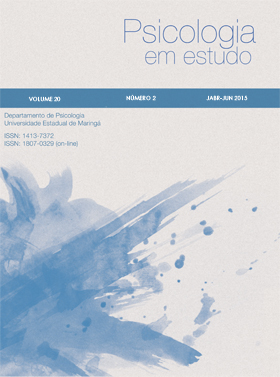DEATH, CULTURE, HEAVY METAL AND INNER EXPERIENCE: SENSATION AND AFFECTIVITY
Abstract
The present study aimed to investigate the possible relations between thanatological referentials present in heavy metal and the affective and sensory experience associated with death by participants of this artistic and cultural field. The research was based in a idiographic and qualitative introspectionist approach for the study of consciousness, whose proceedings culminated, in a first moment, in the identification and description of the emerging phenomenology of these experiences, in a second moment, in the discussion of the cognitive and affective processes underlying the emergence of the phenomenological content; and finally, in a third moment, in the discussion of the possible relations between the reported phenomenologies and the circumscription of death in heavy metal. Taken as a whole, the data indicated that both, the affective field and the sensory field reflects that the inner experience of death theme reflects major parameters of death representation in the West, which appear to overlap the narrower field of death representation in heavy metal.
Downloads
References
Ariès, P. (2012). A história da morte no ocidente. Rio de Janeiro, RJ: Nova Fronteira.
Barbosa, C.G., Melchiori, L.E., & Neme, C.M.B. (2011a). O significado da morte para adolescentes, adultos e idosos. Paidéia, 21(49), 175-185.
Barbosa, C.G., Melchiori, L.E., & Neme, C.M.B. (2011b). Morte, família e a compreensão fenomenológica: revisão sistemática de literatura. Psicologia em Revista, 17(3), 363-377.
Bardin, L. (2015). Análise de conteúdo. Lisboa: Edições 70.
Cave, S. (2012). Immortality: the quest to live forever and how it drives civilization. New York: Crown publishers.
Chalmers, D. (2010). The character of consciousness. New York: Oxford University Press.
Christe, I. (2010). Heavy metal: a história completa. São Paulo: Arx editora.
Fenwick, P. (2013). As experiências de quase morte (EQM) podem contribuir para o debate sobre a consciência?. Revista de psiquiatria clínica, 40(5), 203-207.
Gutiérrez, R.M.V., & Muñoz-Martínez, A.M. (2013). La regulación emocional: precisiones y avances conceptuales desde la perspectiva conductual. Psicologia USP, 24(2), 225-240.
Hales S, Gagliese L, Nissim R, Zimmermann C, Rodin G. (2012). Understanding bereaved caregiver evaluations of the quality of dying and death: an application of cognitive interviewing methodology to the quality of dying and death Questionnaire. Journal of pain and symptom management, 43(2), 195-204.
Hidalgo, C. (2010). Etnografias de la muerte: rituales, desapariciones, VIH-SIDA y resignificación de la vida. Buenos Aires: CICCUS.
Hurlburt, R.T. (2011). Investigating pristine inner experience: moments of truth. Cambridge: Cambridge University Press.
Kastenbaum, R. & Aisenberg, R. (1983). The psychology of death. New York: Springer.
Kovács, M.J. (2008). Desenvolvimento da tanatologia: estudos sobre a morte e o morrer. Paidéia, 18(41), 457- 468.
Kübler-Ross, E. (1996). Sobre a Morte e o Morrer. São Paulo: Martins Fontes.
Magalhães, J.H.G. (2014). O que as pessoas experienciam quando a morte vem à mente? Explorando aspectos cognitivos e fenomenais da experiência interna dirigida à morte entre sujeitos inseridos na cultura heavy metal. Dissertação de Mestrado Não-Publicada, Programa de Pós-graduação em Psicologia Cognitiva, Universidade Federal de Pernambuco, Recife.
Mandler, G. (2007). A history of modern experimental psychology: from James and Wundt to cognitive science. Massachusetts: The MIT press.
Nagel, T. (1974). What is it like to be a bat? The Philosophical Review, 83(4), 435-450.
Nascimento, A.M & Roazzi, A. (2007). A Estrutura da Representação Social da Morte na Interface com as Religiosidades em Equipes Multiprofissionais de Saúde. Psicologia: Reflexão e Crítica, 20(3), 435-443.
Nascimento, A.M. (2008). Autoconsciência situacional, imagens mentais, religiosidade e estados incomuns da consciência: um estudo sóciocognitivo. Tese de Doutorado Não-Publicada, Programa de Pós-graduação em Psicologia Cognitiva, Universidade Federal de Pernambuco, Recife.
Paivio, A. (2007). Mind and it’s evolution: a dual coding theoretical approach. Mauwah: Lawrence Erlbaum.
Pickering. J.(2000). Methods are a Message. In: Velmans, M (Org.), Investigating phenomenal consciousness: new methodologies and maps. (pp. 279-300). Amsterdam/Philadelphia: John Benjamins B.V.
Velmans, M. (2000). An Introduction to Investigating Phenomenal Consciousness. In: Velmans, M. (Org.), Investigating phenomenal consciousness: new methodologies and maps (pp. 1-18). Amsterdam/Philadelphia: John Benjamins B.V.
Pyszczynski, T., Greenberg, J., & Solomon, S. (1999). A dual-process model of defense against conscious and unconscious death-related thoughts: An extension of terror management theory. Psychological Review, 106, 835–845.
Roazzi, M,M., Dias, M..G.B.B & Roazzi, A. (2010). Mais ou menos morto: explorações sobre a formação do conceito de morte em crianças. Psicologia: Reflexão e Crítica, 23(3), 485-495.
Schmidt, B., Gabarra, L,M & Gonçalves, J.R. (2011). Intervenção psicológica em terminalidade e morte: relato de experiência. Paidéia, 21(50), 423-430.
Shihui, H., Qin, J. & Ma, Y. (2010). Neurocognitive processes of linguistic cues related to death. Neuropsychologia, 48, 3436–3442.
Salvagni, A., Savegnago, S.D.O., Gonçalves, j., Quintana, A.M., Beck, C.L.C. (2013). Reflexões acerca da abordagem da morte com crianças. Mudanças – Psicologia da Saúde, 21(2), 48-55.
Weinstein, D. (2000). Heavy Metal: the music and its culture. Boston: Da capo press.
Widera-Wysoczañska, A. (1999). Everyday awareness of death: a qualitative investigation. Journal of Humanistic Psychology, 39, 73–95.
As opiniões emitidas, são de exclusiva responsabilidade do(s) autor(es). Ao submeterem o manuscrito ao Conselho Editorial de Psicologia em Estudo, o(s) autor(es) assume(m) a responsabilidade de não ter previamente publicado ou submetido o mesmo manuscrito por outro periódico. Em caso de autoria múltipla, o manuscrito deve vir acompanhado de autorização assinada por todos os autores. Artigos aceitos para publicação passam a ser propriedade da revista, podendo ser remixados e reaproveitados conforme prevê a licença Creative Commons CC-BY.
The opinions expressed are the sole responsibility of the author (s). When submitting the manuscript to the Editorial Board of Study Psychology, the author (s) assumes responsibility for not having previously published or submitted the same manuscript by another journal. In case of multiple authorship, the manuscript must be accompanied by an authorization signed by all authors. Articles accepted for publication become the property of the journal, and can be remixed and reused as provided for in theby a license Creative Commons CC-BY.
















